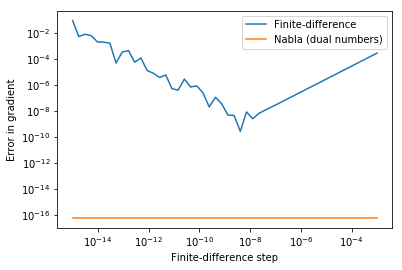Note: this is an unmaintained personal project, use at your own risk.
Automatic, machine-precision forward differentiation in python using dual numbers.
from nabla import grad
def f(x):
return 3*x*x
print(grad(f)(5))Dual(75, [30.])
Example use for logistic regression
def f(x, y, param, z):
return 2*x*y + z**4
x, y, z, param = 1, 2, 3, "this is a non-numeric parameter"
print(f(x, y, param, z))
# Get the gradient w.r.t. x,y,z
# The non-numeric parameter is automatically ignored
print(grad(f)(x, y, param, z))85
Dual(85, [ 4. 2. 108.])
# Find gradient w.r.t y,x
print(grad([1,0])(f)(x, y, param, z))Dual(85, [2. 4.])
from numpy import sin, cos
@grad
def f(x, y):
return sin(x)*cos(y)
print(f(1,2))
# nabla can automatically differentiate w.r.t. a combination of numpy array entries and other function arguments:
print(f(np.array([1,2,3]), 2))Dual(-0.35017548837401463, [-0.2248451 -0.7651474])
[Dual(-0.35017548837401463, [-0.2248451 -0. -0. -0.7651474])
Dual(-0.37840124765396416, [ 0. 0.17317819 0. -0.82682181])
Dual(-0.05872664492762098, [ 0. 0. 0.41198225 -0.12832006])]
from nabla import minimise
def f(x, y, z):
return sin(x+1) + 2*cos(y-1) + (z-1)**2
x0, fval, gradient = minimise(f, [0, 0, 0])
print("Minimum found at x0 = {}".format(x0))
print("Function, gradient at minimum = {}, {}\n".format(fval, gradient))
# Can also minimise w.r.t. a subset of variables
# Here we minimise w.r.t. x and y while holding z=0 fixed
x0, fval, gradient = minimise(f, [0, 0, 0], variables=[0,1])
print("Minimum found at x0 = {}".format(x0))
print("Function, gradient at minimum = {}, {}\n".format(fval, gradient))Minimum found at x0 = [-2.57079546 -2.14159265 1. ]
Function, gradient at minimum = -2.9999999999996243, [ 8.66727231e-07 1.62321409e-14 -3.77475828e-15]
Minimum found at x0 = [-2.57079546 -2.14159265 0. ]
Function, gradient at minimum = -1.9999999999996243, [8.66727231e-07 1.62321409e-14]
import numpy as np
import matplotlib.pyplot as plt
%matplotlib inline
def f(x):
return np.sqrt(3*x + np.sin(x)**2)/(4*x**3 + 2*x + 1)
def analytical_derivative(x):
A = (2*np.sin(x)*np.cos(x)+3)/(2*(4*x**3 + 2*x + 1)*np.sqrt(3*x + np.sin(x)**2))
B = (12*x**2 + 2)*np.sqrt(3*x + np.sin(x)**2) / (4*x**3 + 2*x + 1)**2
return A - B
x = 1
dfdx_nabla = grad(f)(x).dual
dfdx_analytic = analytical_derivative(x)
eps = np.logspace(-15, -3)
dfdx_fd = np.zeros(eps.shape)
for i,e in enumerate(eps):
dfdx_fd[i] = (f(x+e) - f(x))/e
err_nabla = np.abs(dfdx_nabla - dfdx_analytic) * np.ones(eps.shape)
err_fd = np.abs(dfdx_fd - dfdx_analytic)
# Plot error
plt.loglog(eps, err_fd, label='Finite-difference')
plt.loglog(eps, err_nabla, label='Nabla (dual numbers)')
plt.xlabel('Finite-difference step')
plt.ylabel('Error in gradient')
plt.legend()<matplotlib.legend.Legend at 0x7fce4983bfd0>
Compare time taken:
%timeit -n10000 grad(f)(x)
%timeit -n10000 (f(x+1e-8) - f(x))/1e-8124 µs ± 6.93 µs per loop (mean ± std. dev. of 7 runs, 10000 loops each)
8.27 µs ± 366 ns per loop (mean ± std. dev. of 7 runs, 10000 loops each)
